bigbud
Level 3 Rank
  
Posts: 180
|
Post by bigbud on Apr 9, 2012 7:50:30 GMT
In May we have an Earth-Jupiter opposition, and less important an Earth-Venus conjunction So the next wave in solar activity could come around May BB  |
|
bigbud
Level 3 Rank
  
Posts: 180
|
Post by bigbud on Jun 30, 2012 22:15:05 GMT
Here is an attempt to put a very simplified model into one image, focusing on the longer term variation. I have simplified a lot, and there is a bunch of questions that follows… some that I can answer, others not. Anyway, the message is that I see a supercycle of approx 170 years. The last one was 16 solar cycles long, and the one before I think was 15 SCs. Each supercycle seems to have some kind of a grand minimum. The last one had a twin-minimum (Dalton and the 1900). When looking further back, the Wolf and Spörer minima may suggest that the supercycle can be longer and around 200 years. One interesting thing is that the Uranus-Neptun synodic period is ~170 years… which could be significant. We now have begun a grand minimum in this supercycle, and we should see mostly weak cycles for the next ~80 years. 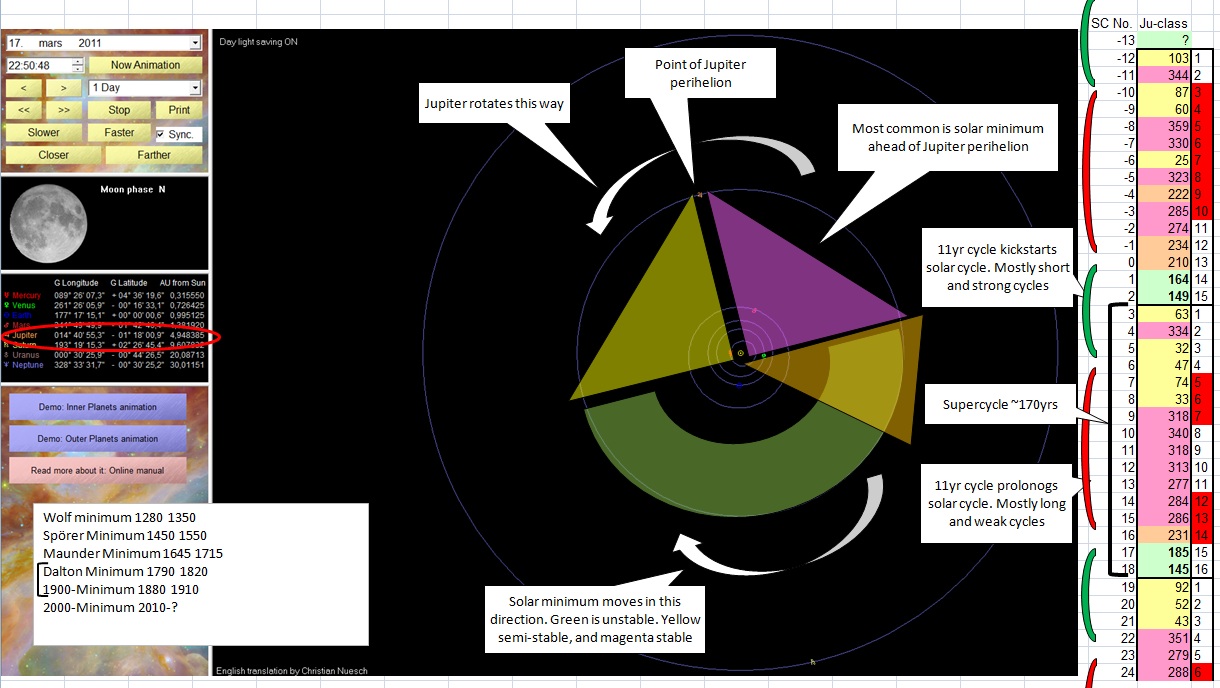 |
|
bigbud
Level 3 Rank
  
Posts: 180
|
Post by bigbud on Jul 1, 2012 19:21:17 GMT
A look at the ~170 year cycle, and grand minima. Looking back 1000 years, and assuming the cycle is 16 solar cycles. Doesn´t look too bad... and there are two cycles that had no minima. Could happen again... but not this century?  This is with alternating 15/16 cycles  |
|
andor
Level 2 Rank
 
Posts: 60
|
Post by andor on Jul 2, 2012 13:46:08 GMT
The current Katun of the Mayas,will roll over 21st December 2012 and that clearly shows the new colder cycle coming!
I think this cycle will peak around this date then!
Let's see not long to go!!
|
|
bigbud
Level 3 Rank
  
Posts: 180
|
Post by bigbud on Jul 2, 2012 15:00:59 GMT
The current Katun of the Mayas,will roll over 21st December 2012 and that clearly shows the new colder cycle coming! I think this cycle will peak around this date then! Let's see not long to go!! Hi My work says the SC24-maximum will be near the tidal-max (by Woods, calculated from the planets Ve, Ea and Ju), which is summer 2014. I expect a long sideways top and the next solar min around 2020-2021 BB  |
|
bigbud
Level 3 Rank
  
Posts: 180
|
Post by bigbud on Jul 2, 2012 19:34:55 GMT
oboy... adding Mercury+Jupiter tidal force really cleared up the mechanism of the Jovian cycle, and the three SC-types ABC... why solar minimum tends to be before or after Jupiter perihelion ----------- so the Jupiter-cycle is really the tidal Mercury-Jupiter-cycle, and the tidal forces depress sunspots (it´s mainly a timing-cycle) then there is the tidal Venus-Earth-Jupiter cycle of 11 years, that has to be studied more thoroughly (and is also a timing-cycle) lastly there is the Jupiter-Saturn cycle which is a strength-cycle, and maybe a different mechanism than tidal forces. Could be that Uranus and Neptun also have significant contributions. More to do...  |
|
bigbud
Level 3 Rank
  
Posts: 180
|
Post by bigbud on Jul 3, 2012 8:45:08 GMT
quite interesting stuff...
recap:
The solar cycle is modulated by three planetary cycles:
X-10 year (half) synodic Jupiter-Saturn cycle
Y-11 year tidal Venus-Earth-Jupiter cycle
Z-12 year Jupiter cycle
The Y and Z cycles are most related to timing of the solar cycle, while the X-cycle is about solar cycle intensity (SSN)
Recent findings:
The 12-year Jupiter cycle is really the tidal Mercury-Jupiter cycle. And strong tidal forces depress sunspots (dissolves them? Cause eruptions and dying spots?)
The 11-year Venus-Earth-Jupiter cycle is really most about Venus-Earth, and where Jupiter is positioned at the Venus-Earth conjunctions/oppositions. Every ~11 years there are strong syzygies (often a cluster of them) that "kills" the sunspotcycle. And when the syzygies are weak, new sunspotcycles can start/accelerate.
----------
Last task is to analyze the Jupiter-Saturn cycle. Is that one also about tidal forces, or is it a different mechanism? Since this cycle is more about intensity, I think it is a different mechanism. Perhaps something about angular momentum, and influence of the solar dynamo. And maybe the other giants Uranus and Neptun also are significant (seen in the grand minima? Gleissberg/Suess?)
Ju-Sa is the most important
Then probably the Sa-Ur of 45,4 years, and Ur-Ne of ~171 years
Interesting will be to see what pattern emerges in the combination of the three Sa-Ur-Ne
|
|
bigbud
Level 3 Rank
  
Posts: 180
|
Post by bigbud on Jul 3, 2012 9:10:56 GMT
looking at current SC24 we have currently sunspot-depression from MeJu-cycle, but this is about to end... and favor sunspot-growth the next ~5 years
However we have strong VeEaJu syzygies at 11.jan 2014 (strongest) and 15.aug 2015 (weaker)
So this SC24 should be topping around January 2014. Have not analysed in detail where the maximums occur relative to these syzygies, so it could be +/- 6 months or so...
-----------
maximum should be just around/after these syzygies, so Jan-Feb 2014 would be my estimate for SC24-maximum.
Also we had a medium syzygy now in June (around Venus-passage), that should depress sunspots from ~July to November 2012
|
|
bigbud
Level 3 Rank
  
Posts: 180
|
Post by bigbud on Jul 4, 2012 15:12:56 GMT
This is a model of the tidal forces from Me, Ve, Ea and Ju (or some M/R^3 influence) Green shows the Mercury-Jupiter tide, which is a "continuous" influence as Mercury has such a short rotational period. The curve shows a double bottom where solar minimum tend to be - I call them B and A. Blue shows the Venus-Earth-Jupiter tide. This is a stronger tidal force than MeJu, but these are singular events, often years apart. Therefore it must be treated somewhat different Tidal forces are shown inverse, so a low curve will depress sunspots (high tidal force depresses sunspots) The next minimum should be around summer 2020 (type B), or closer to summer 2024 (type A) - which will be an unlikely long cycle. So around summer 2020 is the prediction. 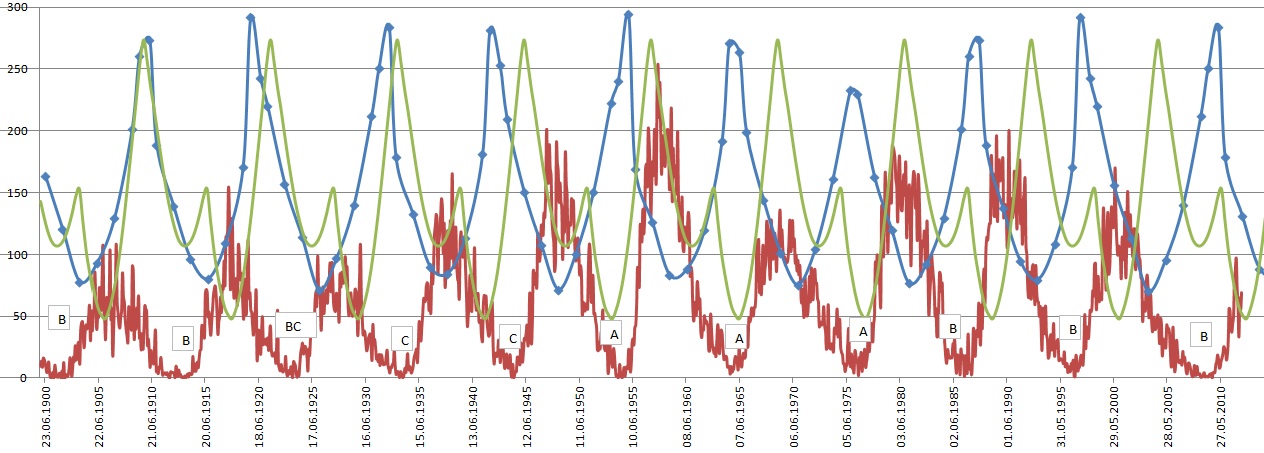 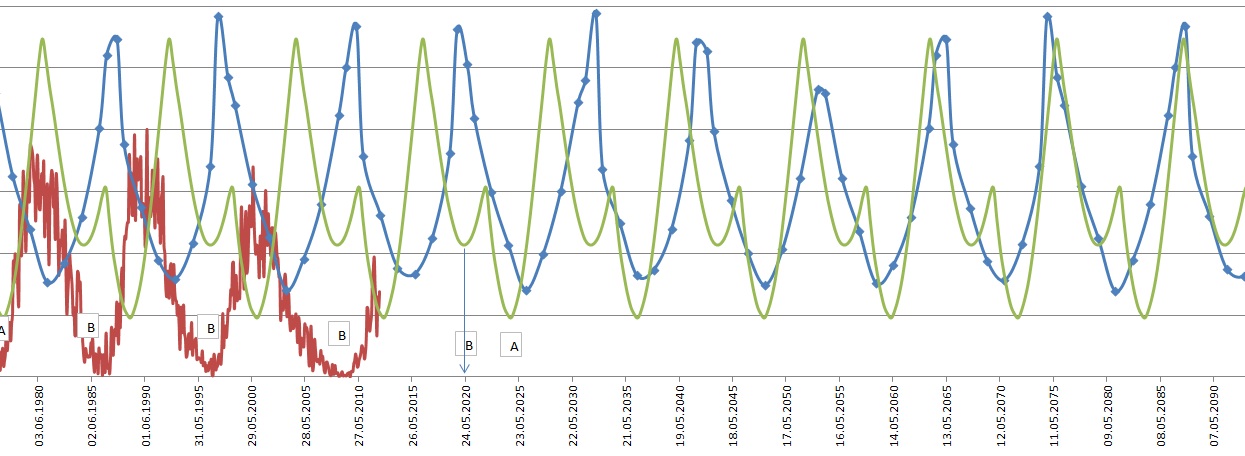 Since the VeEaJu-tide is not a continuous influence, it correlates different to the solar cycle than the MeJu-tide. There seems to be a lagging effect, and a better fit to the solar cycle is when the VeEaJu-curve is inverted (which means inverted back to normal). We see two peaks of high tidal force around Jan 2014 and Sept 2015. Solar maximum should be in this interval (the two other high points are Jun 2012 and April 2017 - unlikely points for maximum) 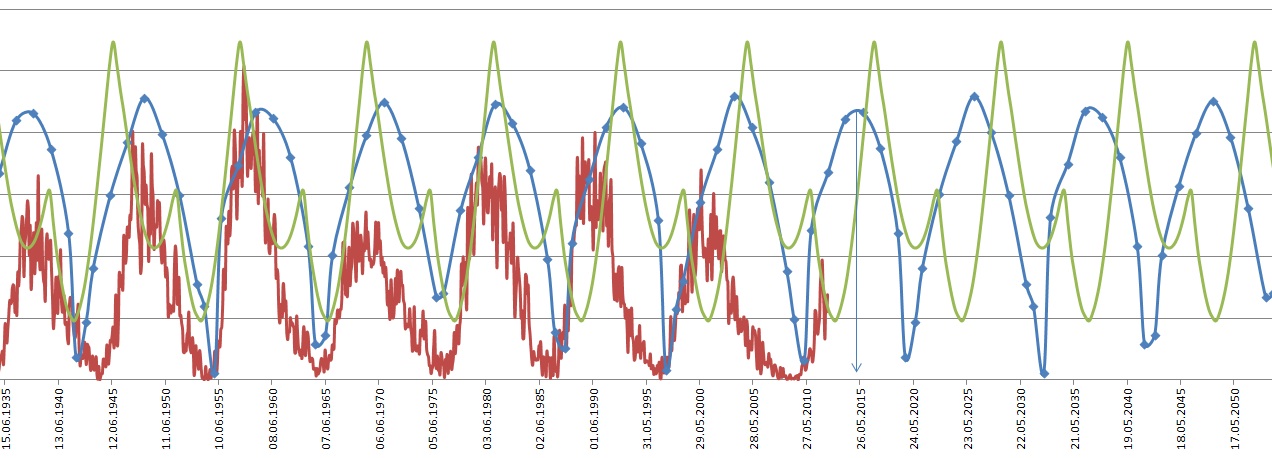 |
|
bigbud
Level 3 Rank
  
Posts: 180
|
Post by bigbud on Jul 4, 2012 18:06:04 GMT
zooming in and showing how things work Still very simplyfied, and the third mechanism JuSa is left out. 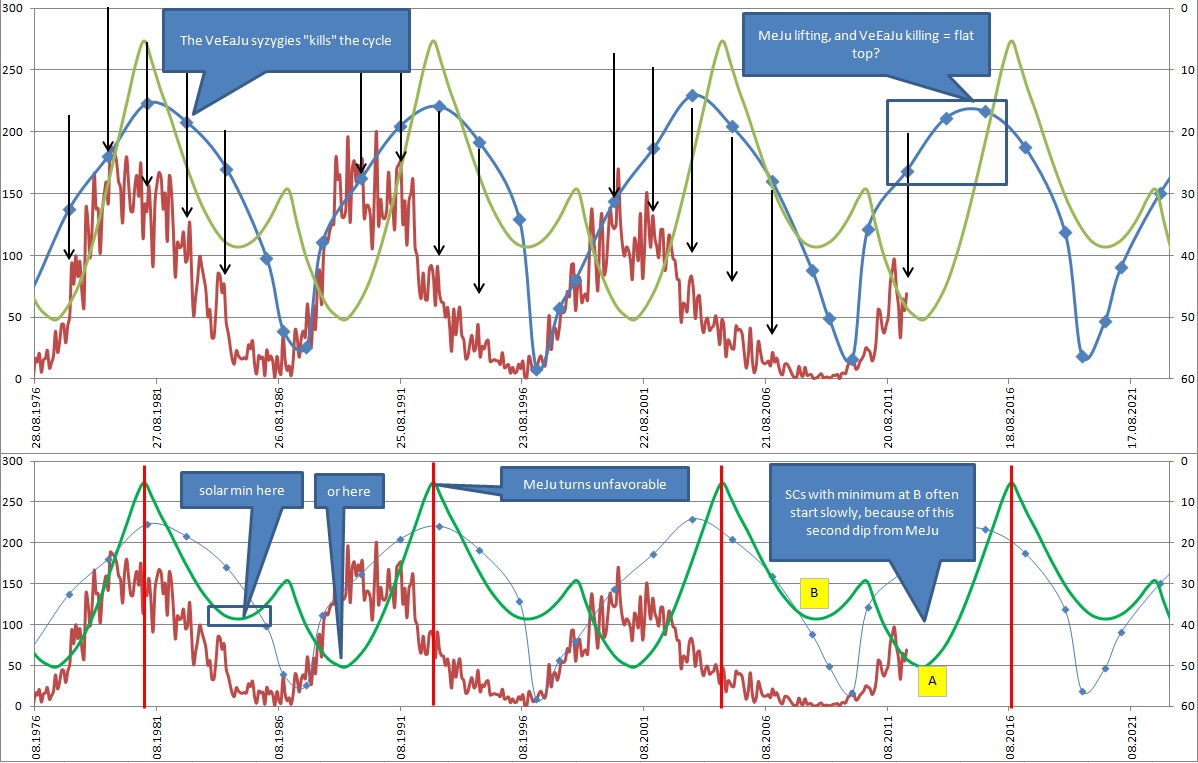 |
|
bigbud
Level 3 Rank
  
Posts: 180
|
Post by bigbud on Jul 4, 2012 19:06:28 GMT
Tidal force is a M/R^3 effect en.wikipedia.org/wiki/Tidal_forceThe planets have relative value about Me 0,93 Ve 2,18 Ea 1 Ju 2,26 Sa 0,11 So Saturn and the outer planets are irrelevant But my work says there is a strong JuSa-influence on the sunspotcycle... so Saturn must be relevant in some way... and maybe Uranus and Neptun also are connected to the supercycles? Perhaps there is a M/R^2-effect? Then we get values Ve 1,57 Ju 11,75 Sa 1,05 Ur 0,04 Ne 0,02 Allthough Venus is stronger than Saturn, I think Saturn still is more significant because Venus passes by so quickly, while Jupiter-Saturn rotate slowly and overlap for a longer period. My work says JuSa conjunctions and oppositions have pretty much the same effect, and they also seem to depress solar activity just like the tidal-effect. Uranus and Neptun seem to be pretty insignificant... specially when we consider that the peri-/aphelion results in a range of 0,93-1,16 for Saturn. So when looking for a longer term variation, it could be more interesting to see for patterns in the peri-/aphelins for Jupiter and Saturn and variations through time... |
|
bigbud
Level 3 Rank
  
Posts: 180
|
Post by bigbud on Jul 5, 2012 8:00:51 GMT
Doesn´t seem to be any strong variation of the peri-/aphelions in the JuSa-cycle, other than the obvious ~60 year cycle. There is a longer cycle, but I haven´t found the excact lenght yet. So I wonder if I have to take another look at Uranus/Neptun and perhaps the barycentre or angular momentum of solar system. ------------- The cycles of MeJu and VeEaJu provide some understanding of sunspot cycle length. The MeJu-cycle indicates that the most common length should be around 11,9 years (+/- 1 year), and the theoretical minimum length is about 7,6 years and the maximum about 16,1 years The VeEaJu-cycle gives more precise numbers. A sunspot cycle should be close to a multiple of Venus-Earth cycles (~584 days), BUT every ~11 years the VeEaJu-cycle does a shift... where the first cycle has its syzygies at Venus-Earth conjunctions, while the next at oppositions. So the sunspot cycle should be a (multiple of 584 days) + (292 days) And the result is then (years): 8,8 10,4 12 13,6 15,2 This should fit well - see Timo personal.inet.fi/tiede/tilmari/#tdist |
|
bigbud
Level 3 Rank
  
Posts: 180
|
Post by bigbud on Jul 5, 2012 11:09:22 GMT
very interesting pattern i Barycentre distance to solar surface, with help from SolarSimulator2 and the Barycentre-spreadsheet from Williams.
There is the expected ~171 year pattern from UrNe. However the cycle is 179 years, and then makes a short cycle of 140 years. So this results in a supercycle of 856 years.
That means that we have the analogies:
680AD-minimum = Spörer
800AD-minimum missing (= Maunder)
Oort-minimum = Dalton + 1900
Medieval-maximum ~1200 (minimum missing) = year 2015... will we get a minimum this time? Or another maximum?
Probably there are even bigger supercycles at play here...
Immediately I notice that the barycentre distance is much weaker in this 856yr cycle than around the Medieval maximum. So when looking at several 856yr cycles, I should be able to see the bigger cycle...
It also probably means that we should get a weaker maximum than the Medieval.
-----------
hmm, we seem to have a shorter supercycle of ~677 years, making a low here and the next 100 years. So that would mean no midieval maximum, but rather a deep minimum.
---------
oboy... weak barycentre in the centuries ahead... ice-age coming up? Have to look further back to see if the correlation holds
|
|
|
|
Post by france on Jul 5, 2012 16:46:28 GMT
|
|
bigbud
Level 3 Rank
  
Posts: 180
|
Post by bigbud on Jul 5, 2012 18:18:23 GMT
thanks, just fine... she is 3 years now  Interesting link... Mars however is not part of this... I have pretty much figured out the 11-year sunspot cycle, but have not seen the light regarding the bigger cycles and grand minima/maximum. The Jupiter-Saturn cycle is giving us a hint about something, and I think Uranus/Neptun still can be part of this. I was hoping to see some convincing patterns doing some simplyfied work. However I dont know whether I have found anything good yet  Do anyone have data for barycentre distance to solar surface for +/- some thousand years? I guess weekly data should be fine, or monthly also can do. |
|